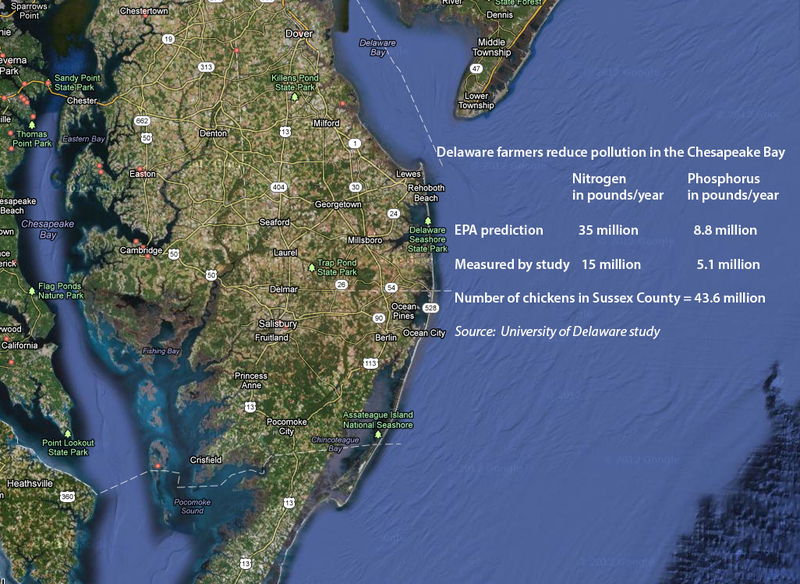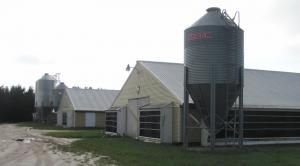As a top poultry-producing poultry state, Delaware generates poultry waste and its associated nitrogen and phosphorous – key pollutants of the Chesapeake and Inland bays. However, a new study shows the U.S. Environmental Protection Agency has over estimated nitrogen and phosphorous produced by Delaware farms.
University of Delaware scientists, agricultural officials and Delaware Department of Natural Resources and Environmental Control researchers studied 800 of Delmarva's 5,000 chicken houses to measure pollution generated for comparison with EPA predictions, which UD professor Dr. Jim Glancey said date from the 1980s and '90s.
The study found Sussex County produced about 15 million pounds of nitrogen per year, compared to the EPA's estimate of 35 million pounds. The research also shows Delaware produces 5.1 million pounds of phosphorus per year, compared to the EPA's estimate of 9 million pounds per year.
Phosphorous has been greatly reduced since phytase was added to chicken feed in the late 1990s allowing the birds to better absorb phosphorus, Glancey said.
“The industry has attempted to, and has achieved some success in making their waste product more environmentally friendly,” Glancey said. “It's pretty clear, between genetics, feed technologies and better growing environments, the industry has reduced waste produced in the poultry industry.”
Glancey also looked at Virginia, West Virginia, Maryland and Pennsylvania statistics on nitrogen and phosphorous pollution and found the data varied from state to state. While Delaware adds 20 pounds of phosphorous per ton of poultry manure, Virginia adds only 15 pounds per ton.
“The take-home message was that the EPA's approach of one number applies to the whole watershed is not valid. There are differences from one state to the next,” Glancey said.
Data to be used for updated models
Margaret Enloe, spokeswoman for the Chesapeake Bay Partnership said officials have been asking for updated Delaware data for years, so the UD study is good news.
She said because the study has not been peer-reviewed, it is considered research, which the program's agriculture workgroup and poultry industry subcommittee will use in updating pollution models. Delaware had never before provided data, so the information can be used to improve prediction models, she said. The new model will be implemented in 2017.
The agriculture workgroup and others met May 22-23 in Hyattsville, Md., to review pollution models. The two-day conference included representatives from Pennsylvania, Maryland , Virginia, West Virginia and Delaware to talk updates to water quality regulations.
Mark Dubin, agricultural technical coordinator for the University of Maryland and coordinator for the agriculture workgroup, said Glancey's research triggered the creation of the poultry subcommittee. While Delaware has submitted its research, Virginia, West Virginia and Pennsylvania are still developing data.
This is the beginning of discussions, Dubin said. Recommendations are expected by the end of summer.
“I think it's been a positive reaction to the Delaware data; there's a lot of interest in it,” said Dubin, who grows grain crops on 140 acres in the Potomac Rivershed in southern Pennsylvania. “As a farmer, the new models will have an effect on everyone living and working in the bay watershed.”
Inland Bays modeling
In the Inland Bays watershed in eastern Sussex County, similar models could apply, said Agriculture Secretary Ed Kee. About 200 chicken houses are operating in the Inland Bays watershed, he said.
Chris Bason, director of the Center for the Inland Bays, said the center doesn't have the modeling capability of the Chesapeake Bay Partnership, but he is working to update water-quality models that show how the estuary works as water flows through it.
“We have to continually update and reinvigorate our models with new data,” Bason said. “We are always learning new things about the ecosystem.”
Bason said the University of Delaware research shows improvements in the poultry industry and how nutrients have been reduced.
“Their work should be commended for finding the right numbers,” Bason said. “It's a chore to put the science in these models, but they can't remain stagnant, so this is a real advancement.”
Or as Kee puts it, “We think there appears to be some progress in improving the water quality, but we're also the first to acknowledge there's a long way to go.”
Funding for farmers
USDA Natural Resources Conservation Service is launching a new project to monitor water quality on agricultural fields within targeted areas of the Chesapeake Bay Watershed.
Farmers using edge-of-field monitoring in Delaware’s Clear Brook-Nanticoke River Watershed, located between Bridgeville and Seaford, can apply for funding. Sign up by June 14. Only the highest ranked applications will be funded as this is a competitive process throughout the bay watershed.
To learn more, call 302-856-3990 Ext. 3 or go to www.de.nrcs.usda.gov.



















































